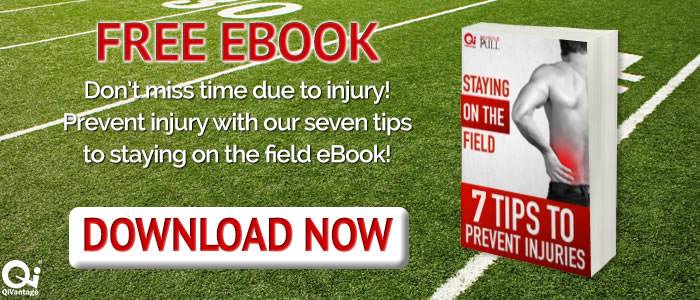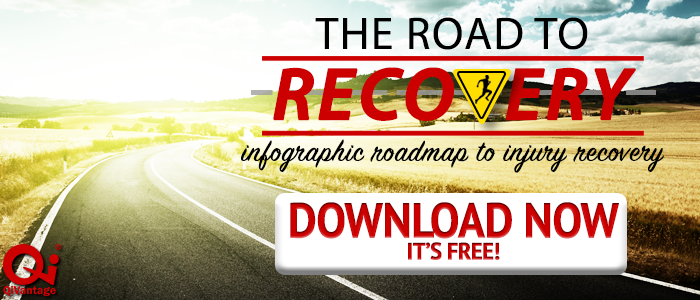You never realize how important your hip flexors are to your everyday life until you have an injured hip flexor. Hip flexor treatment isn’t easy either. It’s a very active portion of your body and almost every move affects it in some way.
When you go to the doctor with a hip flexor injury, they’re likely to tell you to use the R.I.C.E. method, take some NSAIDS (anti-inflammatory drugs), and let your body heal itself (assuming it’s not a very serious injury which may require surgery). For an athlete, the sit-and-wait approach just doesn’t cut it. We get anxious and frustrated waiting for our injuries to heal themselves. It just takes too long.
Well we’ve got eight steps to help you recover from your hip flexor injury faster than relying on R.I.C.E. to fix it.
In fact, if you’ve read our other post, How to Recover from an Ankle Sprain, you know that we don’t have a whole lot of love for the R.I.C.E. method. Rest, ice, compression, and elevation are fine to use as soon as the injury occurs, but R.I.C.E. is not a long-term solution to healing even though we treat it as one. If you want to heal fast (and fully) then you’ve got to get beyond R.I.C.E.
Using R.I.C.E. the first few hours after an injury is fine, but once the swelling is gone it is time to move on. This method can actually slow the healing process if you use it past this time.
Same with NSAIDS (Advil, Motrin, etc.), they are good to us for the first week to manage pain but a steady diet of these pills is not good for your body. Also you don’t want to mask the pain entirely or you’re more likely to overstress the injury and make it worse.
So if hip flexor treatment is a serious priority for you, these steps will help you get there:
1. R.I.C.E. Immediately
We may have just bashed on the concept of R.I.C.E., but like we also said, it has a place immediately after injuring your hip flexor. Stop what you’re doing (don’t try to power through – we know you thought about it!). Use this method until the swelling has gone down and your pain has started to subside. AS SOON as this happens, move to step two. Like we mentioned, the R.I.C.E. method becomes a hindrance to healing beyond this point.
2. Move to Heat
Once your swelling is gone and pain level has dropped, it is time to move to heat. We get the question, “when do I ice and when do I heat?” all the time and the answer is that you should move to heat as soon as possible. It’s simple biology – heat will improve blood circulation which helps to remove toxins and waste that you’ve created when you injured the area. It also provides more nutrients and oxygen to the injured area allowing it to begin the healing process. Heat is all about helping your body heal.
3. Injury Treatment Kit
We have worked for years to perfect our injury treatment kits using only all-natural ingredients. It’s all based off of ancient Chinese medicine and practices. All four of our injury treatment kits are designed for a different situation (mild injury, moderate injury, severe injury, or nagging/chronic injury). We highly recommend adding an injury treatment kit to your healing process. It’s guaranteed to speed up your recovery!
PRO TIP: If you’re not sure which category you fall into, take our FREE Injury Assessment and let our trained injury specialists deliver customized suggestions and tips specific for your injury.
4. Water
Once you’ve sustained an injury your body has toxins and waste that need to be removed from your body. Especially if it is a muscle injury, you need to help the healing process by making sure that your muscles have enough water to properly remove these toxins and begin to repair. No matter your injury, increasing your water intake is vital.
5. Light Stretching
Once you’re able to move around more comfortably you can start light stretching. Just like our pro tip from before, if it hurts – STOP! The point here is not to push through the pain or to grow your muscles. It’s to repair the damage that you’ve done to it. Go easy and gradually work your way into more strenuous stretching. Be sure to mind your form and keep a strong core to avoid a re-injury or a separate injury from overcompensation.
6. Foam Rolling
Foam rolling will help force the toxins that have built up in your muscles out. It can be uncomfortable, but it can do a lot of good. It’s likely to be a little painful and tender, but again, just take it slow and don’t try to speed it up by pushing too hard.
7. Strength Training
Strength training should not begin until your pain is completely or almost completely gone. Even then, you need to remember that you were just injured and you’re likely not going to be able to jump right back into what you used to do. Take it slow and we recommend utilizing machines instead of free weights at the beginning. For example, squatting right away could be a major mistake. Instead of squats, maybe utilize the leg press (lighter weight!) and work your way back to squats.
8. Prevention
After any injury, you’re more prone to re-injury. Just because your hip flexor doesn’t hurt anymore doesn’t mean that you can’t be right back to where you were when you first hurt it with one misstep. You definitely don’t want to have to go through this whole process again so it’s time to think prevention. It’s not a sexy topic, but avoiding potential future injuries and staying on the field is worth it!
Download our FREE 7 Tips to Prevent Injuries eBook filled with tips on stretching mistakes you’re probably making, statistics on injuries, and even a study by Runner’s World!
Are you more of a visual person? Us too. Our Road to Recovery Infographic will help you move step-by-step from your fresh injury to full strength. Download it now and follow the road to recovery!





Leave A Comment